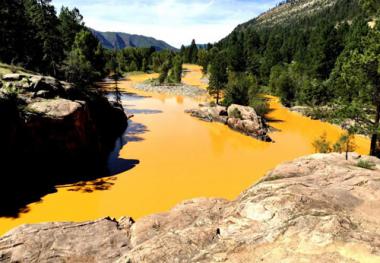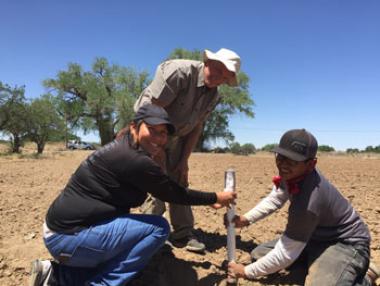Gold King Mine Spill - Diné Exposure Project
Project Introduction
yellow-river_body.jpg

Following the Gold King Mine spill on August 5, 2015 near Silverton, CO, researchers from the University of Arizona Superfund Research Program (UA SRP) received numerous inquiries from a diverse range of stakeholders regarding the spill. It was quickly apparent that there was a need to synthesize the information being released from all sources about the spill. The UA SRP team responded by drafting a fact sheet, “Understanding the Gold King Mine Spill”. Later, a 2-page condensed version of the fact sheet was also created.
UA SRP’s rapid response efforts to the Gold King Mine spill helped many in communities touched by the event, and resulted in two awards to study exposure, risk and risk perceptions from the spill. The awards were an Agnese Nelms Haury Challenge Grant and an NIEHS R21 Grant. These projects are led by UA SRP investigator, Dr. Karletta Chief, and UA SRP collaborator, Dr. Paloma Beamer, but include many academic and community partners.
Learn more about Gold King Mine Diné Exposure Project (GKMS-DEP) through Youtube Video in the Navajo Language with English subtitles.
Project Goals
- Determine exposure of Diné residents in three communities (Upper Fruitland, NM; Shiprock, NM; and Aneth, UT) to the Spill.
- Measure lead and arsenic in river water, river sediment, agricultural soil, irrigation water, and irrigation sediment.
- Find out what people are concerned about when using the San Juan River after the Spill and find out the risk based on the environmental and household results.
Outreach Materials
- Understanding the Gold King Mine Spill - This bulletin synthesized the best information available while providing resources to investigate further.
- Gold King Mine Spill Community Sheet - Condensed two pages version of the above information bulletin.
- Diné Citizen Science Protocol Instructions on Sampling Water for Emergency Response.
- Farming is Life Brochure. GKMS-DEP seeking Diné Farmers to monitor their corn, water, and soil on their farms from seed to harvest for 2018.
Articles
- Water, Hogans, and Rocks - Website article written by Alondra Harris with contributions from others on the trip on March 28, 2016.
- Water Is Our Life: How a Mining Disaster Affected the Navajo Nation - Article published in TruthOut on May 16, 2016.
Powerpoints
- Environmental Sampling Results: Water - This presentation was provided at the May 24, 2017 Teach-in Shiprock on the Navajo Reservation. It provides general results of the water sampling collected in the area.
Videos
- Water Results Video, Narrated in Navajo
- Soil and Sediment Results Video, Narrated in Navajo
- Household Results Video, Narrated in Navajo
Radio
- KTNN Radio Forum Archive (03/20/2018). The GKMS-DEP hosted a radio forum on Tuesday, March 20, 2018 at 6 - 8 PM MDT on Navajo radio station KTNN (AM 660 & FM 101.5) & KWRK (FM 96.1). The panelists discussed how they were involved in the monitoring and research activities on the Navajo Nation after the Gold King Mine Spill, what results they found, and answered questions from radio listeners.
- KTNN Radio Forum Archive (03/19/2019). One of the two radio forums GKMS-DEP hosted in the same week of the Shiprock Ag Days in the spring of 2019. Panelists from the University of Arizona, Navajo Nation, and New Mexico State University presented on the current status of monitoring and research activities on the Navajo Nation after the Gold King Mine Spill and answered questions from radio listeners.
Immediate Response Efforts
In response to the concerns raised by tribal community members living along the impacted waterways, UA SRP investigators and Cooperative Extension specialists partnered to draft a bulletin, “Understanding the Gold King Mine Spill.” During this time, UA SRP investigators also responded to multiple media requests for information. Dr. Jim Field provided expertise for two Arizona Daily Star articles, commenting on the spill’s potential to impact Arizona drinking water, as well as the long-term impacts of metals in sediments in both, the recent spill as well as last year’s mine spill in Sonora, Mexico. Dr. Paloma Beamer also spoke about the potential for long-term impacts to health and the environment in an Arizona Farm Bureau article, which provided a link to the UA SRP Water Booklets and Videos web page as a resource for concerned consumers. Dr. Raina Maier and Dr. Karletta Chief appeared on Arizona Week, a news magazine produced by Arizona Public Media. The pair spoke about UA SRP’s work with legacy mining sites and tribal communities, the extent of the contamination and potential for impact to the environment, and the significance of the spill to Navajo livelihoods and cultural beliefs. Chief was also featured on an episode of Native America Calling (starting approx. 44:25), a live call-in program which can be heard on over 70 public, community, and tribal radio stations and the internet. She spoke about the legacy of mining impacts on the Navajo Nation, as well as water quality following the recent spill.
Long-Term Characterization and Community Outreach Efforts
After the waterways were no longer a metal-rich yellow, the Navajo communities living in the footprint of the contamination still found their lives altered in many ways. With irrigation canals representing the source of agricultural water for Navajo farmers throughout the region, many communities found themselves with no choice but to abruptly suspend irrigation, thus leaving them with no crops to harvest. The community of Shiprock, New Mexico had originally elected to leave its irrigation canals closed for one year following the spill; however, the canals of Shiprock did reopen eight months later in April of 2016.
While drinking water was determined to be safe for human consumption a short time after the spill, the long-term health effects for Community concerns addressed people using the San Juan River remained unclear. Drs. Chief and Beamer began working with Dine’ community leaders shortly after the spill to develop strategies for working with their impacted communities. After securing their NIEHS R21 grant in January of 2016, Drs. Chief and Beamer were able to enhance their community outreach efforts, teaming with tribal community leaders to hold public forums and teach-ins. Key leaders involved in these outreach collaborations and efforts include Mae-Gilene Begay, Perry Charley, Research awards Janene Yazzie, Chili Yazzie, and Arnold Clifford, in addition to Northern Arizona University (NAU) counterparts, Drs. Manley Begay and Jani Ingram. A number of projects stemming from these collaborative efforts received funding in the spring of 2016, including the University of Arizona Agnes Nelms Haury Foundation grant for which Drs. Chief and Beamer collaborated with Dine' leader, Janene Yazzi.
j.yazzie_photo3_body.jpg

Concurrent with these community engagement efforts, UA SRP also launched a large-scale sampling strategy; forming a multi-institute collaboration with NAU, Nex Mexico State University Extension, and a local tribal community college, Dine' College. Throughout the summer of 2016 as the spill's one-year anniversary approached, researchers and students from these learning institutions embarked on a number of field excursions to collect environmental samples to characterize soil and water impacts throughout the impacted region. These sample collection efforts also provided another level of community engagement, as well as valuable learning experiences in teamwork and cultural diversity for the student collaborators.
Congressional Testimony
As SRP researchers, trainees, and community members worked towards spill characterization and community recovery on the ground, by late spring of 2016, reverberations of the spill's impact made their way to the U.S. Congress. UA SRP Associate Director, Dr. Clark Lantz, testified at a Field Oversight Hearing organized by the U.S. Senate Committee on Indian Affairs to address the spill and agency response efforts. The following week, UA SRP Director, Dr. Raina Maier, provided testimony at the 2016 Capitol Hill Policy Briefing Series, where she pointed out that the Gold King Mine spill demonstrates a need to turn greater attention to cleaning up abandoned mining sites throughout the western U.S.
Project Newsletters
- One Year after the Gold King Mine Spill - August 2016 " Reflection newsletter.
- Navajo Gold King Mine Exposure Project Newsletter” - Quarterly newsletter sharing the Gold King Mine Spill Exposure Project progress: Fall 2016, ISSUE 1 Winter 2017, ISSUE 2
- Gold King Mine Spill Diné Exposure Project - Spring 2017 Issue 3 - Updates on the project status, highlights project partners, and descriptions of events that have taken place.
- Gold King Mine Spill Diné Exposure Project - Summer/Fall 2017 Issue 4 & 5 - Updates on the project status, highlights project partners, and descriptions of events that have taken place.
- Gold King Mine Spill Diné Exposure Project - Winter 2017 Issue 6 - Updates on the project status, highlights project partners, and descriptions of events that have taken place.
- Gold King Mine Spill Diné Exposure Project - Spring 2018 Issue 7 - Updates on the project status, highlights project partners, and descriptions of events that have taken place.
- Gold King Mine Spill Diné Exposure Project - Summer-Fall 2018 Issue 8 & 9 - Updates on the project status, highlights project partners, and description of events that have taken place.
- Gold King Mine Spill Diné Exposure Project - Spring 2019 Issue 10 - Updates on the project status, highlights project partners, and description of events that have taken place.
- Gold King Mine Spill Dine Exposure Project - Summer 2019 Issue 11 - Updates on the project status, highlights project partners, and description of events that have taken place.
- End of Project Reflection. Navajo leaders share their thoughts on the Gold King Mine Diné Exposure Project.
Want to Learn More?
- Follow the Gold King Mine Spill Diné Exposure Project on Facebook!
- Go to our new YouTube Channel
- Send GKM-DEP an email: goldkingproject@gmail.com

